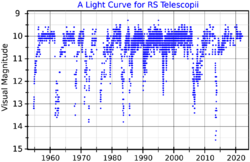Astronomy:RS Telescopii
| Observation data Equinox J2000.0]] (ICRS) | |
|---|---|
| Constellation | Telescopium |
| Right ascension | 18h 18m 51.2224s[2] |
| Declination | −46° 32′ 53.427″[2] |
| Apparent magnitude (V) | 10.67[3] |
| Characteristics | |
| Spectral type | R0 |
| B−V color index | 2.100±0.510[3] |
| Variable type | R CrB[4] |
| Astrometry | |
| Radial velocity (Rv) | −3.0[3] km/s |
| Proper motion (μ) | RA: −2.730[2] mas/yr Dec.: −6.670[2] mas/yr |
| Parallax (π) | 0.1732 ± 0.0166[2] mas |
| Distance | 19,000 ± 2,000 ly (5,800 ± 600 pc) |
| Details | |
| Radius | 73[5] R☉ |
| Luminosity | 288 (at max)[6] L☉ |
| Surface gravity (log g) | 1.0[7] cgs |
| Temperature | 5,800[6] K |
| Other designations | |
| Database references | |
| SIMBAD | data |
RS Telescopii, abbreviated RS Tel, is a variable star in the southern constellation of Telescopium. It is a dim star with an apparent visual magnitude of 10.67,[3] which is much too faint to be visible without a telescope. The variability of this star was discovered by Evelyn F. Leland and announced by Edward C. Pickering in 1910.[9] It was first studied by Cecilia H. Payne in 1928 at the Harvard College Observatory.[10][11]
This is an R-type carbon star with a class of R0.[12] RS Tel is a typical R Coronae Borealis variable[10]—an extremely hydrogen-deficient supergiant thought to have arisen as the result of the merger of two white dwarfs; fewer than 100 have been discovered as of 2012.[4] It has under 55%[13] the mass of the Sun and an effective temperature of around 5,800 K.[6] The spectrum of the star shows anomalously weak lines of hydrogen, with strong lines of C2, CN, and neutral carbon.[14]
RS Tel has a maximum magnitude of 9.6 and a minimum magnitude 16.5.[15] The star undergoes large, random variations in brightness on a time scale of thousands of days with no apparent periodicity.[16] The star is surrounded by a circumstellar shell of dust which radiating an infrared excess.[16]
References
- ↑ "Download Data". AAVSO. https://www.aavso.org/data-download.
- ↑ Jump up to: 2.0 2.1 2.2 2.3 2.4 Brown, A. G. A. (2021). "Gaia Early Data Release 3: Summary of the contents and survey properties". Astronomy & Astrophysics 649: A1. doi:10.1051/0004-6361/202039657. Bibcode: 2021A&A...649A...1G. Gaia EDR3 record for this source at VizieR.
- ↑ Jump up to: 3.0 3.1 3.2 3.3 Anderson, E.; Francis, Ch. (2012). "XHIP: An extended hipparcos compilation". Astronomy Letters 38 (5): 331. doi:10.1134/S1063773712050015. Bibcode: 2012AstL...38..331A.
- ↑ Jump up to: 4.0 4.1 Tisserand, P. et al. (2012). "The Ongoing Pursuit of R Coronae Borealis Stars: ASAS-3 Survey Strikes Again". Astronomy & Astrophysics 551: 22. doi:10.1051/0004-6361/201220713. A77. Bibcode: 2013A&A...551A..77T.
- ↑ Stassun, Keivan G. et al. (2019-10-01). "The Revised TESS Input Catalog and Candidate Target List". The Astronomical Journal 158 (4): 138. doi:10.3847/1538-3881/ab3467. ISSN 0004-6256. Bibcode: 2019AJ....158..138S.
- ↑ Jump up to: 6.0 6.1 6.2 Bergeat, J.; Knapik, A.; Rutily, B. (2002). "Carbon-rich giants in the HR diagram and their luminosity function". Astronomy and Astrophysics 390 (3): 967. doi:10.1051/0004-6361:20020525. Bibcode: 2002A&A...390..967B.
- ↑ Hema, B. P.; Pandey, Gajendra; Lambert, David L. (2012). "The Galactic R Coronae Borealis Stars: The C2 Swan Bands, the Carbon Problem, and the 12C/13C Ratio". The Astrophysical Journal 747 (2): 102. doi:10.1088/0004-637X/747/2/102. Bibcode: 2012ApJ...747..102H.
- ↑ "RS Tel". SIMBAD. Centre de données astronomiques de Strasbourg. http://simbad.u-strasbg.fr/simbad/sim-basic?Ident=RS+Tel.
- ↑ Pickering, Edward C. (March 1910). "20 new variable stars in Harvard Map, Nos. 2, 5, 32, 44 and 53". Astronomische Nachrichten 184: 5. doi:10.1002/asna.19101840104. Bibcode: 1910AN....184....5P. https://zenodo.org/record/1424857.
- ↑ Jump up to: 10.0 10.1 Milone, Luis A. (October 1990). "Identification charts for southern R Coronae Borealis-stars". Astrophysics and Space Science 172 (2): 263–271. doi:10.1007/BF00643318. Bibcode: 1990Ap&SS.172..263M.
- ↑ Payne, Cecilia H. (October 1928). "The R Coronae Type Variables RS Telescopii and Y Muscae". Harvard College Observatory Bulletin 861: 11–12. Bibcode: 1928BHarO.861...11P.
- ↑ Knapp, G. et al. (May 2001). "Reprocessing the Hipparcos data for evolved giant stars II. Absolute magnitudes for the R-type carbon stars". Astronomy and Astrophysics 371: 222–232. doi:10.1051/0004-6361:20010348. Bibcode: 2001A&A...371..222K.
- ↑ Stasińska, G.; Szczerba, R.; Schmidt, M.; Siódmiak, N. (2006). "Post-AGB stars as testbeds of nucleosynthesis in AGB stars". Astronomy and Astrophysics 450 (2): 701. doi:10.1051/0004-6361:20053553. Bibcode: 2006A&A...450..701S.
- ↑ Bidelman, William P. (January 1953). "The Spectra of Certain Stars whose Atmospheres may be Deficient in Hydrogen". Astrophysical Journal 117: 25. doi:10.1086/145665. Bibcode: 1953ApJ...117...25B.
- ↑ BSJ (11 November 2011). "RX Telescopii". AAVSO Website. American Association of Variable Star Observers. http://www.aavso.org/vsx/index.php?view=detail.top&oid=36259. Retrieved 26 June 2014.
- ↑ Jump up to: 16.0 16.1 Feast, M. W. et al. (February 1997). "The R Coronae Borealis stars - I. Infrared photometry and long-term variations". Monthly Notices of the Royal Astronomical Society 285 (2): 317–338. doi:10.1093/mnras/285.2.317. Bibcode: 1997MNRAS.285..317F.
 |


